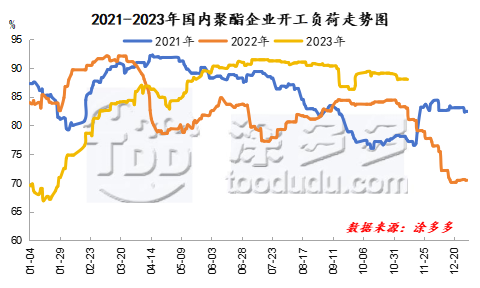Polyester: Demand-driven reduces polyester load but remains high
Lead: As terminal textile demand begins to enter the traditional off-season, the operating load of Chinese weaving companies has gradually declined. Under the pressure of weakening demand, the production and sales of Chinese polyester companies have begun to weaken. However, there is currently no significant pressure on the inventory pressure of polyester companies. Therefore, the load on polyester companies remains high.
Starting from the end of October, China's polyester raw material PTA and ethylene glycol markets have shown a slight upward trend. However, the polyester market has been suppressed by weak demand, and the market has maintained a weak and volatile pattern. Therefore, processing fees of polyester companies have begun to be significantly reduced. Starting from the 6th, with the continued decline of international crude oil and pressure from the cost side, the polyester raw material PTA market has weakened. Without support from the cost side, the polyester market is still difficult to get rid of the weak pattern. Therefore, processing fees of Chinese polyester companies remain at a low level. As of now, the profit of polyester chip products is 8 yuan/ton, the profit of polyester bottle chip products is-292 yuan/ton, the profit of polyester filament products is-242 yuan/ton, and the profit of polyester staple fiber products is 93 yuan/ton.

Since mid-October, the overall start-up of China's polyester enterprises has remained at a high level of around 88%-90%. Polyester enterprises have reduced equipment maintenance, and industry start-ups have temporarily remained at a high level. Only polyester bottle sheet enterprises have reduced production of equipment due to the pressure of losses., the start-up of the polyester bottle sheet industry has dropped to a low of above 70%. The main reason why the load on polyester enterprises still maintains a high level is that there is no significant pressure on enterprise inventories. As of last weekend, among them, the polyester chip enterprise warehouse existed for about 6-8 days, the polyester POY inventory was about 15-17 days, and the polyester DTY inventory was about 27-30 days, the polyester FDY inventory was about 20-22 days, and the polyester staple fiber inventory was about 7-10 days. There is still just downstream demand, and polyester companies mostly reduce production or stop production at the end of the year. Therefore, there is no need for companies to reduce production in a short period of time. If there is no expectation of major changes in the market, polyester companies may survive until the end of the year to carry out centralized maintenance.
At present, terminal textile demand has entered the off-season of traditional demand, winter orders are coming to an end, the textile market atmosphere has cooled, the number of terminal orders has declined simultaneously, the market transaction volume has begun to shrink, and market orders have been unclear for the time being. Therefore, Chinese weaving companies have begun to reduce their load. At present, the comprehensive start of weaving has dropped back to around 78%, and the inventory of finished grey cloth has begun to accumulate slightly. In the later period, as the off-season atmosphere gradually deepens, there are still expectations for a further decline in the start of weaving companies in the later period.
With the gradual weakening of polyester demand, the production and sales of Chinese polyester companies have recently begun to weaken. Among them, the production and sales of polyester filament companies have remained at around 40 - 60%, the production and sales of polyester staple fiber companies are around 50 - 60%, and the production and sales of polyester chip companies are around 3- 50%. As the order volume of polyester companies continues to decline, the inventory pressure of polyester companies will gradually increase in the later period. At present, the polyester raw material market remains high. Under the pressure of high costs, polyester companies will continue to ship at high prices, and the efforts of manufacturers to reduce prices in the later period will be tested.
